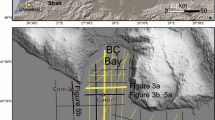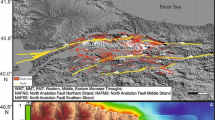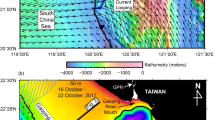Abstract
Deep currents such as the Pacific Deep Western Boundary Current (DWBC) are strengthened periodically in Milankovitch cycles. We studied periodic fluctuations in seismic reflection pattern and reflection amplitude in order to detect cycles in the sedimentary layers of Bounty Trough and bounty fan, east of New Zealand. There, the occurrence of the obliquity frequency is caused only by the DWBC. Therefore, it provides direct evidence for the spatial extent of the DWBC. We can confirm the extent of the DWBC west of the outer sill, previously only inferred via erosional features at the outer sill. Further, our data allow an estimation of the extent of the DWBC into the Bounty Trough, limiting the DWBC presence to east of 178.15°E. Using the presented method a larger dataset will allow a chronological and areal mapping of sedimentation processes and hence provide information on glacial/interglacial cycles.







Similar content being viewed by others
References
Atlas Hydrographic GmbH (2010) ATLAS PARASOUND Deep-Sea parametric sub-bottom profiler. http://www.atlas-elektronik.com/what-we-do/hydrographic-systems/parasound/, Bremen
Carter L, Carter RM (1988) Late quaternary development of left-bank-dominant levees in the Bounty Trough. N Z Mar Geol 78:185–197. doi:10.1016/0025-3227(88)90108-9
Carter L, Carter RM (1993) Sedimentary evolution of the Bounty Trough: a Cretaceous rift basin, southwestern Pacific Ocean. In: Ballance PF (ed) South Pacific Sedimentary Basins, vol 2., Sedimentary Basins of the WorldElsevier, Amsterdam, pp 51–67
Carter RM, Carter L (1996) The abyssal Bounty Fan and lower Bounty Channel: evolution of a rifted-margin sedimentary system. Mar Geol 130:181–202. doi:10.1016/0025-3227(95)00139-5
Carter L, McCave IN (1997) The sedimentary regime beneath the Deep Western Boundary Current inflow to the Southwest Pacific Ocean. J Sediment Res 67:1005–1017. doi:10.1306/d42686b2-2b26-11d7-8648000102c1865d
Carter L, Carter RM, Nelson CS, Fulthorpe CS, Neil HL (1990) Evolution of Pliocene to recent abyssal sediment waves on Bounty Channel levees. N Z Mar Geol 95:97–109. doi:10.1016/0025-3227(90)90043-J
Carter RM, Carter L, Davy B (1994) Seismic stratigraphy of the Bounty Trough, south-west Pacific Ocean. Mar Pet Geol 11:79–93. doi:10.1016/0264-8172(94)90011-6
Carter RM et al (1999) Site 1122: turbidites with a contourite foundation. In: Carter RM, McCave IN, Richter C, Carter L (eds) Proceedings of the ocean drilling program, initial reports, vol 181. Ocean Drilling Program, College Station. doi:10.2973/odp.proc.ir.181.106.2000
Carter L, Carter RM, McCave IN (2004a) Evolution of the sedimentary system beneath the deep Pacific inflow off eastern New Zealand. Mar Geol 205:9–27. doi:10.1016/s0025-3227(04)00016-7
Carter RM, McCave IN, Carter L (2004b) 1. Leg 181 synthesis: fronts, flows, drifts, vocanoes, and the evolution of the Southwestern Gateway to the Pacific Ocean, Eastern New Zealand. In: Richter C (ed) Proceedings of the ocean drilling programm, scientific results, vol 181. Ocean Drilling Program, College Station. doi:10.2973/odp.proc.sr.181.210.2004
Clark PU, Pisias NG, Stocker TF, Weaver AJ (2002) The role of the thermohaline circulation in abrupt climate change. Nature 415:863–869. doi:10.1038/415863a
Cooley JW, Tukey JW (1965) An algorithm for the machine calculation of complex. Fourier Ser Math Comput 19:297–301
Crundwell M, Scott G, Naish T, Carter L (2008) Glacial–interglacial ocean climate variability from planktonic foraminifera during the Mid-Pleistocene transition in the temperate Southwest Pacific, ODP Site 1123. Palaeogeogr Palaeoclimatol Palaeoecol 260:202–229. doi:10.1016/j.palaeo.2007.08.023
Davy B (1993) The Bounty Trough—basement structure influences on Sedimentary Basin evolution. In: Ballance PF (ed) South Pacific sedimentary basins. Sedimentary Basins of the World, vol 2. Elsevier, Amsterdam, pp 69–92
Erickson SN, Jarrard RD (1998) Velocity-porosity relationships for water-saturated siliciclastic sediments. J Geophys Res: Solid Earth 103:30385–30406. doi:10.1029/98jb02128
Gohl K (2003) Structure and dynamics of a submarine continent: tectonic-magmatic evolution of the Campbell Plateau (New Zealand) Report of the RV SONNE cruise SO-169, Project CAMP 17 January to 24 February 2003, vol 457. Alfred Wegner Institut, Helmholtz Centre for Polar and Marine Reseach, Bremerhaven. doi:10.2312/BzPM_0457_2003
Griggs GB, Carter L, Kennett JP, Carter RV (1983) Late Quaternary marine stratigraphy southeast of New Zealand. Geol Soc Am Bull 94:791–797. doi:10.1130/0016-7606(1983)94<791:lqmsso>2.0.co;2
Grobys JWG, Gohl K, Davy B, Uenzelmann-Neben G, Deen T, Barker D (2007) Is the Bounty Trough off eastern New Zealand an aborted rift? J Geophys Res: Solid Earth. doi:10.1029/2005JB004229
Hall IR, McCave IN, Shackleton NJ, Weedon GP, Harris SE (2001) Intensified deep Pacific inflow and ventilation in Pleistocene glacial times. Nature 412:809–812
Hall IR, McCave IN, Zahn R, Carter L, Knutz PC, Weedon GP (2003) Paleocurrent reconstruction of the deep Pacific inflow during the middle Miocene: reflections of East Antarctic ice sheet growth. Paleoceanography. doi:10.1029/2002pa000817
Hamilton EL (1978) Sound velocity–density relations in sea-floor sediments and rocks. J Acoust Soc Am 63:366–377. doi:10.1121/1.381747
Horn M, Uenzelmann-Neben G (2015) The Deep Western Boundary Current at the Bounty Trough, east of New Zealand: indications for its activity already before the opening of the Tasmanian Gateway. Mar Geol 362:60–75. doi:10.1016/j.margeo.2015.01.011
Kuhlbrodt T, Griesel A, Montoya M, Levermann A, Hofmann M, Rahmstorf S (2007) On the driving processes of the Atlantic meridional overturning circulation. Rev Geophys 45:RG2001. doi:10.1029/2004rg000166
Lu H, Fulthorpe CS, Mann P (2003) Three-dimensional architecture of shelf-building sediment drifts in the offshore Canterbury Basin. N Z Mar Geol 193:19–47. doi:10.1016/S0025-3227(02)00612-6
McCave IN, Carter L, Hall IR (2008) Glacial–interglacial changes in water mass structure and flow in the SW Pacific Ocean. Quatern Sci Rev 27:1886–1908. doi:10.1016/j.quascirev.2008.07.010
McCave IN, Crowhurst SJ, Kuhn G, Hillenbrand CD, Meredith MP (2014) Minimal change in Antarctic Circumpolar Current flow speed between the last glacial and Holocene. Nat Geosci 7:113–116. doi:10.1038/ngeo2037
Miller KG et al (2005) The phanerozoic record of global sea-level change. Science 310:1293–1298
Nafe JE, Drake CL (1957) Variation with depth in shallow and deep water marine sediments of porosity, density and the velocities of compressional and shear waves. Geophysics 22:523–552. doi:10.1190/1.1438386
Naish T et al (2009) Obliquity-paced Pliocene West Antarctic ice sheet oscillations. Nature 458:322–328. doi:10.1038/nature07867
Neil HL, Carter L, Morris MY (2004) Thermal isolation of Campbell Plateau, New Zealand, by the Antarctic circumpolar current over the past 130 kyr. Paleoceanography 19:PA4008. doi:10.1029/2003pa000975
Orsi AH, Whitworth T III, Nowlin WD Jr (1995) On the meridional extent and fronts of the Antarctic Circumpolar Current. Deep Sea Res Part I 42:641–673. doi:10.1016/0967-0637(95)00021-w
Osborn NI, Ciesielski PF, Ledbetter MT (1983) Disconformities and paleoceanography in the southeast Indian Ocean during the past 5.4 million years. Geol Soc Am Bull 94:1345–1358. doi:10.1130/0016-7606(1983)94<1345:dapits>2.0.co;2
Reid JL (1997) On the total geostrophic circulation of the pacific ocean: flow patterns, tracers, and transports. Prog Oceanogr 39:263–352. doi:10.1016/S0079-6611(97)00012-8
Schiel S (2009) The expedition of the research vessel” Polarstern” to the Antarctic in 2007 (ANT-XXIV/1) Berichte zur Polar-und Meeresforschung (Reports on polar and marine research), p 592
Sheriff RE, Geldart LP (1982) 4.3.2 Resolution. In: Exploration seismology Volume I: history, theory and data acquisition. Cambridge University Press, Cambridge, pp 117–122
Shipboard Scientific Party (2000) Site 1122: turbidites with a contourite foundation, vol 2. Ocean Drilling Program, College Station. doi:10.2973/odp.proc.ir.181.106.2000
Spiess V (1992) Digitale Sedimentechographie—Neue Wege zu einer hochauflösenden Akustostratigraphie, vol 35. Univerität Bremen, Bremen
Talley LD (2007) Pacific Ocean. The World Ocean Circulation Experiment (WOCE) hydrographic atlas series, vol 2. International WOCE Project Office, Southampton
Tiedemann R et al (2012) Cruise Report SO213: SOPATRA. Alfred Wegener Institute, Helmholtz Centre for Polar and Marine Research, Bremerhaven
Uenzelmann-Neben G, Grobys JWG, Gohl K, Barker D (2009) Neogene sediment structures in Bounty Trough, eastern New Zealand: influence of magmatic and oceanic current activity. Geol Soc Am Bull 121:134–149. doi:10.1130/B26259.1
Warren BA (1973) Transpacific hydrographic sections at Lats. 43°S and 28°S: the SCORPIO expedition—II. Deep Water Deep Sea Res Oceanogr Abst 20:9–38. doi:10.1016/0011-7471(73)90040-5
Weatherall P et al (2015) A new digital bathymetric model of the world’s oceans. Earth Space Sci 2:331–345. doi:10.1002/2015ea000107
Weigelt E, Uenzelmann-Neben G (2007) Orbital forced cyclicity of reflector strength in the seismic records of the Cape Basin. Geophys Res Lett 34:L01702. doi:10.1029/2006gl028376
Zachos JC, Pagani M, Sloan L, Thomas E, Billups K (2001) Trends, rhythms, and aberrations in global climate 65 Ma to Present. Science 292:686–693
Acknowledgments
We are grateful for the support of Captain H. Andresen and his crew during RV Sonne cruise 169 and Captain O. Meyer and his crew during RV Sonne cruise 213/2 as well as the Parasound watch keepers during both cruises. Additionally, we would like to thank Dr. Robert Larter and Dr. Neil Mitchell for their helpful comments and suggestions on an earlier version of this manuscript. We are further grateful for the helpful comments of two anonymous reviewers and the editor R. Urgeles. The cruises and this research were funded by the Bundesministerium für Bildung und Forschung under contract number 03G0169A and 03G0213A. The Parasound data this paper is based on can be found in the PAGAEA (www.pangaea.de) Database.
Author information
Authors and Affiliations
Corresponding author
Rights and permissions
About this article
Cite this article
Horn, M., Uenzelmann-Neben, G. The spatial extent of the Deep Western Boundary Current into the Bounty Trough: new evidence from parasound sub-bottom profiling. Mar Geophys Res 37, 145–158 (2016). https://doi.org/10.1007/s11001-016-9268-1
Received:
Accepted:
Published:
Issue Date:
DOI: https://doi.org/10.1007/s11001-016-9268-1




